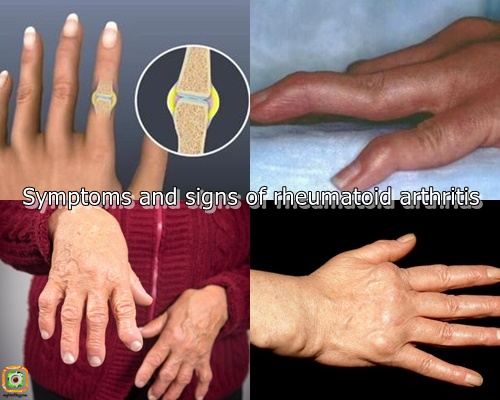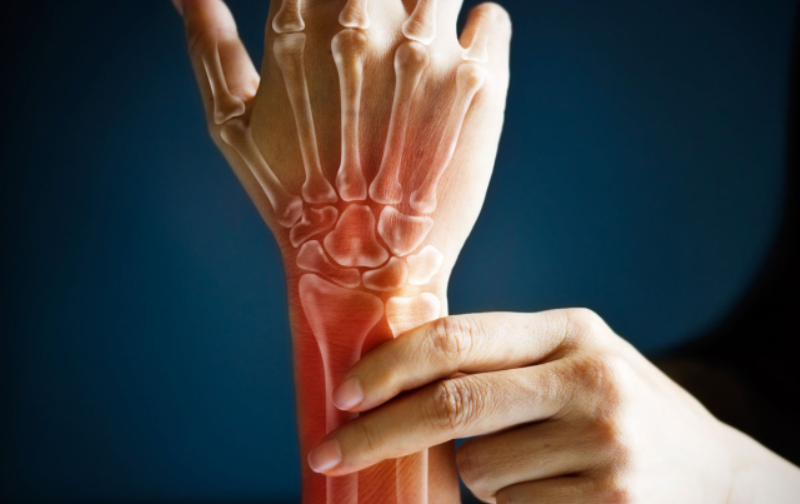Rheumatoid arthritis (RA) is a systemic and autoimmune illness in which the immune system concentrates on the joints rather than other organs, resulting in a chronic inflammatory process. Women are the most commonly affected, and the disease usually strikes during their most productive adult years, peaking between the ages of 35 and 50.
Rheumatoid arthritis is a systemic disease since it can affect other organs in addition to the joints. As a result, articular manifestations (symptoms and signs in the joints) and extraarticular manifestations (symptoms and signs in other organs and organ systems) are both part of the rheumatoid arthritis clinical picture.
Articular manifestations
The predominant symptom of rheumatoid arthritis is joint inflammation, namely synovitis (inflammation of the synovial membrane, which coats the inner surface of the joints). Polyarticular (affecting more than four joints) is the most common onset, followed by oligoarticular (affecting two to four joints) and monoarticular (affecting one joint alone) (affects only one joint). Because the grip is usually symmetrical, inflammation of both knees, shoulders, and wrists is common.
If inflammation is present in a joint, it will show up in the following ways:
- Swelling. Swelling is common in RA-affected and inflamed joints. The etiology is assumed to be a mix of events, including synovial membrane growth and hypertrophy, inflammatory synovial fluid buildup, and joint capsule thickening.
- Pain. Rheumatoid arthritis is characterized by pain as the most common symptom. The source of the discomfort is assumed to be the joint capsule, which is densely packed with unpleasant nerve fibers. If a person has this ailment, it is more or less present all of the time. It is emphasized during movement, i.e. when the affected joints are distended and stretched. It can indicate which joints are afflicted, but the severity of the pain is unrelated to the level of inflammation.
- Stiffness. One of the most common symptoms of this condition is morning stiffness. It’s a day-long feeling of stiffness in aching joints that might last anywhere from one to many hours. Only once this fades will the patient be allowed to resume normal activity. The accumulation of fluid in the inflammatory tissues of the joint during sleep is assumed to be the cause of this uncomfortable feeling. The condition is more aggressive the longer the morning stiffness lasts.
- Heat. Some of the affected major joints, such as the knee, can become hot. Synovitis is assumed to be the cause of the rise in local temperature (inflammation of the synovial membrane).
- Redness. Local redness occurs in rare cases and is usually accompanied by pain and swelling of the affected joint.
During its evolution, rheumatoid arthritis can affect virtually all joints including:
- Wrist and interphalangeal joints In RA, these are the joints that are most usually affected. The changes in the tiny joints of the wrists are mostly symmetrical, with swelling and pain accompanying them, resulting in movement restriction.
- The elbow joint Early on in the condition, inflammation of the synovial membrane of the elbows causes the ligaments that hold the joint together to deteriorate. Many persons with RA who have inflammation of the elbow joints are unaware that they are unable to fully extend their elbows, bringing the forearm to an anatomical position.
- Wrist that is flat. The shoulder joints are the most commonly afflicted, affecting approximately half of all patients and up to 80% of older males. Pain, especially at night, and limited movement are the most common symptoms. Swelling of the shoulder joint is uncommon.
- Foot and ankle. These joints are affected in the early stages with approximately the same prevalence as the wrist joints. The front part of the foot is most often affected, swelling, pain and restriction of movement are present. As the disease progresses, the toes expand outward and inward, resulting in deformities of the feet such as hallux valgus and claws.
- Knee. In rheumatoid arthritis, the knee is one of the most usually afflicted joints. It affects roughly 30% of people in the early stages of the disease. The discomforts that occur during the inflammatory phase of the knee include pain, edema, and restriction of movement.
- How much is it? Rheumatoid arthritis of the hip does not appear clinically until later in the disease’s progression. However, approximately 20% of individuals have substantial hip disease development, which is a serious handicap. Hip infection is characterized by pain and tenderness to the touch, which is increased by and tilt when walking.
- Joint of the jaw (Temporomandibular). In 50% of individuals, the jaw joint is altered. If this joint is afflicted, the patient will have numbness and discomfort, which will be especially noticeable when touched, and the agony will often be so severe that the individual will be unable to open his mouth.
- Intervertebral joints are a type of intervertebral joint. Changes in the joints of the spine can cause headaches, tingling feelings in the arms and legs, and, in extremely rare cases, sphincter incontinence owing to spinal cord compression. As the condition advances, it can irritate the blood vessels that supply the intervertebral joints, causing vomiting, difficulty swallowing, double vision, and temporary visual loss.
Extraarticular manifestations

Although RA predominantly occurs in women, when it comes to extraarticular symptoms and signs, they are more common in men.
Extraarticular manifestations include:
- Manifestations on the skin. Rheumatoid nodules are the most prevalent cutaneous sign of RA, with 20-30% of individuals having them. They are solid subcutaneous formations that occur mostly on mechanically stressed surfaces, such as the interphalangeal joints, elbows, and Achilles tendon. Rarely, rheumatoid nodules can develop in the lungs, meninges, myocardium, and pericardium, and manifest with different symptoms depending on where they are found.
- Manifestations of the haematological system. Anemia affects practically every individual with RA at some point during their illness. The inability of erythrocytes to absorb iron, decreased resorption, decreased erythropoiesis, reduced erythrocyte lifespan, and gastrointestinal microbleeding are all possible causes of RA anemia. Anemia is related to the severity of the disease, meaning it worsens with worsening RA and improves with bettering RA. It’s also crucial to understand that rheumatoid anemia does not respond to standard anemic therapies; in fact, the only way to treat it is to treat RA. Anemia may be accompanied by neutropenia, thrombocytopenia, or thrombocytosis.
- Manifestations in the lungs. Pulmonary fibrosis, pleural inflammation, and the formation of rheumatoid nodules in the lungs are only a few of the various respiratory signs of RA.
- Manifestations in the kidneys. Gliomaphritis is a type of kidney disease that affects 40% of people. Their occurrence can be problematic because it’s difficult to tell if they’re a natural element of the disease or a side effect of RA treatment.
- Manifestations in the eyes. Episcleritis and scleritis, or sclera inflammation, are two ocular symptoms. The symptoms can be mild to severe, and blindness is an uncommon complication.
- Symptoms of the cardiovascular system. Pericarditis, or inflammation of the pericardium, is the most prevalent sign of RA in the cardiovascular system (the lining of the heart). Severe, stabbing chest pain, shortness of breath, and tachycardia are all symptoms of pericarditis.
- Symptoms of the nervous system. Peripheral neuropathy is a neurological symptom of RA that affects a tiny percentage of patients. The development of vasculitis of the small blood arteries that feed the nerves, resulting in demyelination and ischemic neuropathy, is the cause of this condition.



